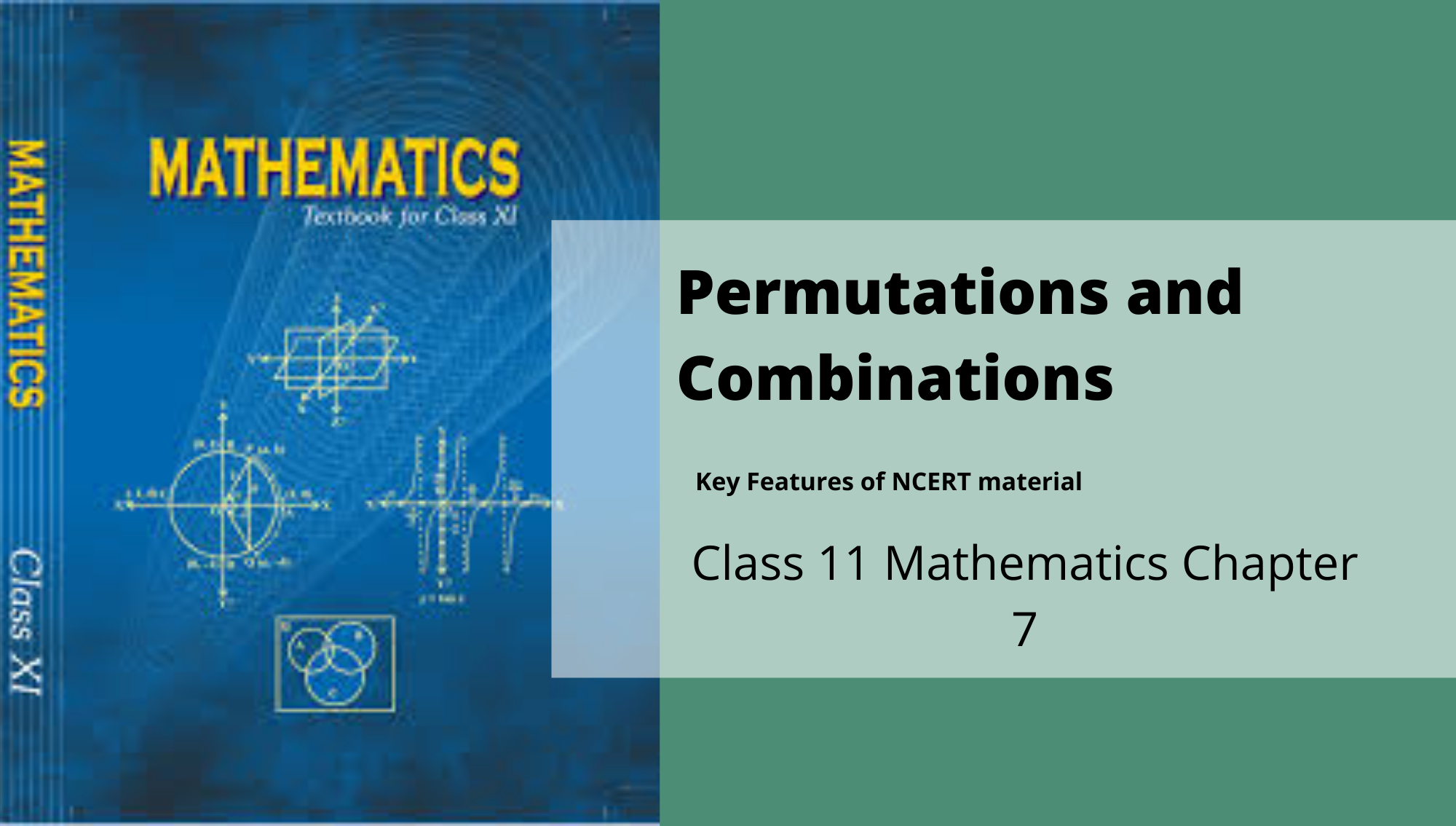Permutations and Combinations: Maths Class 11 Chapter-7

Key Features of NCERT Material for Class 11 Maths Chapter 7 – Permutations and Combinations
Quick revision notes
In Chapter 6 of Class 11 : you must have learnt about Linear Inequalities. In chapter 7: you will learn about Permutation and Combination.
Fundamental Principles of Counting
-
Multiplication Principle
If first operation can be performed in m ways and then a second operation can be performed in n ways. Then, the two operations taken together can be performed in mn ways. This can be extended to any finite number of operations.
If first operation can be performed in m ways and another operation, which is independent of the first, can be performed in n ways. Then, either of the two operations can be performed in m + n ways. This can be extended to any finite number of exclusive events.
Factorial
For any natural number n, we define factorial as n ! or n = n(n – 1)(n – 2) … 3 x 2 x 1 and 0!= 1!= 1
Permutation
Each of the different arrangement which can be made by taking some or all of a number of things is called a permutation.
Mathematically The number of ways of arranging n distinct objects in a row taking r (0 ≤ r ≤ n) at a time is denoted by P(n ,r) or npr
Important Results on’Permutation
- The number of permutations of n different things taken r at a time, allowing repetitions is nr.
- The number of permutations of n different things taken all at a time is nPn= n! .
- The number of permutations of n things taken all at a time, in which p are alike of one kind, q are alike of second kind and r are alike of third kind and rest are different is n!/(p!q!r!)
- The number of permutations of n things of which p1are alike of one kind p2 are alike of second kind, p3 are alike of third kind,…, Pr are alike of rth kind such that p1 + p2 + p3 +…+pr = n is n!/P1!P2!P3!….Pr!
- Number of permutations of n different things taken r at a time,
when a particular thing is to be included in each arrangement is r.n – 1Pr – 1.
when a particular thing is always excluded, then number of arrangements = n – 1Pr - Number of permutations of n different things taken all at a time, when m specified things always come together is m!(n – m + 1)!.
- Number of permutations of n different things taken all at a time, when m specified things never come together is n! – m! x (n – m + 1)!.
Fundamental Principles of Counting
Multiplication Principle: Suppose an operation A can be performed in m ways and related with every method of performing of An, another operation B can be performed in n ways, at that point complete number of performance of two operations in the provided request is mxn ways. This can be stretched out to any limited number of operations.
Addition Principle: If an operation A can be performed in m ways and another operation S, which is independent of A, can be performed in n ways, at that point An and B can performed in (m + n) ways. This can be stretched out to any limited number of restrictive events.
Factorial
The proceeded with result of first n common number is called factorial ‘n’.
It is signified by n! or on the other hand n! = n(n – 1)(n – 2)… 3 × 2 × 1 and 0! = 1! = 1
Permutation
Every one of the distinctive arrangement which can be made by taking a few or the entirety of various items is called permutation.
Permutation of n various articles
The quantity of orchestrating of n objects taking all at once, signified by nPn, is given by nPn = n!
The quantity of an arrangement of n objects taken r at once, where 0 < r ≤ n, meant by nPr is given by
nPr =
Properties of Permutation
Important Results on Permutation
The quantity of permutation of n things taken r at once, when redundancy of article is permitted is nr.
The quantity of permutation of n objects of which p1 are of one kind, p2 are of second kind,… pk are of kth kind with the end goal that p1 + p2 + p3 + … + pk = n is
Number of permutation of n various items taken r at once,
At the point when a specific article is to be remembered for every arrangement is r. n-1Pr-1
At the point when a specific article is constantly rejected, at that point number of arrangements = n-1Pr.
Number of permutations of n various articles taken all when m indicated protests consistently meet up is m! (n – m + 1)!.
Number of permutation of n various items taken all when m indicated protests never meet up is n! – m! (n – m + 1)!.
Combinations
Every one of the various determinations made by taking a few or the entirety of various items irrespective of their arrangements is called combinations. The quantity of choice of r objects from; the given n objects is indicated by nCr, and is given by
nCr =
Properties of Combinations


0 responses on "Permutations and Combinations: Maths Class 11 Chapter-7"